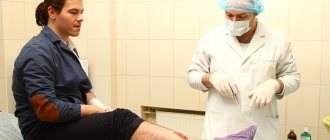BCG: what is it?
The BCG vaccine is used to prevent severe forms of tuberculosis.
It also protects against the most dangerous complications if a person does get sick. Tuberculosis is a common infectious disease (Fig. 1). In the world, up to 10 million people fall ill with it every year, and up to 1.4 million people. dies from this disease. In Russia, the incidence of tuberculosis has been declining in recent years. In 2021 it amounted to 41.2 people. per 100,000 population, and mortality is 5.2 people. per 100,000 population. Despite this, tuberculosis infection remains dangerous, and BCG vaccination is important to protect against it.
Figure 1. General information about tuberculosis. Source:
The BCG vaccine is live. It contains live vaccine strains. They are obtained using weakened bovine tuberculosis bacilli Mycobacterium bovis.
M. bovis is a mycobacterium of the tuberculosis complex that can cause tuberculosis in humans in the same way as the main causative agent of the disease, Koch bacillus (Mycobacterium tuberculosis). Bovine tuberculosis bacillus and Koch's bacillus have a number of similarities and differences. M. bovis produces a similar immune response and can be weakened in vitro. This allows the strain to be used for the production of a live attenuated vaccine.
Back in 1908, the development of BCG began in France. The vaccine was named after the first letters of the surnames of its creators, Albert Calmette and Camille Guérin: Bacillus Calmette-Guérin or BCG. It was tested in 1921, but the tests were unsuccessful. Later it was transferred to the USSR. Since the 1950s, the mass use of BCG for vaccination began in the USSR and other countries. New vaccines are currently being developed, but for now BCG remains the only means of immunoprophylaxis against tuberculosis.
In countries where the incidence of tuberculosis is high, WHO recommends that all healthy newborns be vaccinated in the first days of life. Russia is one of such countries. In regions where the incidence of tuberculosis is decreasing or is low, vaccination against tuberculosis is carried out selectively, only for risk groups.
“FOR WHITES ONLY?”
When researching the effectiveness of the BCG vaccination, a strange feature was discovered: it “works” effectively only in countries with a temperate climate. Thus, clinical studies conducted in the UK have proven a protective effect of 60% to 80%. But the further south you go, the worse it is, and in countries with an equatorial climate, the effectiveness of BCG turned out to be quite insignificant.
In global statistics, infectious diseases are still the leading cause of death. But in countries with developed healthcare, the average person has already forgotten about the destructive epidemics of the past, and only specialists and lovers of the classics are aware of the horrors of smallpox, cholera or tetanus.
Just a hundred years ago, most children did not live to adulthood, dying from infectious diseases, and only extensive reproduction saved humanity from extinction. Today, in the Russian mortality structure, 1.6% of people die from infections.
While diseases of the cardiovascular system claim the lives of 57% of Russians (according to Rosstat for 2010). Overall life expectancy has increased significantly over the past hundred years, so that in developed countries most people die of “old age” (i.e. cancer, heart attacks and strokes). To what do we owe such happiness? Where did the old epidemics go?
Two women speaking through flu masks during an epidemic, 1918 © Keystone/Getty Images
Sanitary and hygienic measures played a significant role. The incidence of many fecal-oral infections (cholera, typhoid fever, etc.) was minimized when the population began to be supplied with chlorinated water. Outbreaks of the same cholera occur from time to time today, affecting up to 5 million people and killing up to 100 thousand annually, but today this problem concerns almost exclusively 3rd world countries (in 2010, large outbreaks were noted in Nigeria, Chad, Cameroon and Haiti). Only fiction and film classics remind us of past cholera epidemics in Europe (for example, “Death in Venice” by Luchino Visconti).
Antibiotics, which began to be widely used since the 40s of the last century, also played a huge role in the fight against bacterial infections. Wonderful drugs have appeared on the pharmaceutical market that can cure not only bacterial, but also some viral infections, such as viral hepatitis. We will not belittle the importance of condoms in controlling the spread of sexually transmitted diseases.
However, assessing the epidemiological retrospective, we come to the conclusion that vaccines played the greatest role in the fight against dangerous infections. Of course, it is still possible to find an American today with legs paralyzed due to polio, but since the mid-1990s, this disease has no longer been recorded in the Western Hemisphere. There is no longer any smallpox in the world (the last case was registered in Somalia in 1977), but until recently this infection was a planetary disaster.
In the 18th century in Russia, every 7th child died from smallpox, and in the 20th century the virus claimed the lives of almost half a billion people! It was smallpox, as well as other infections brought to South and Central America, that destroyed indigenous civilizations.
Preventive vaccination against cholera in 1966.
The word “vaccine” itself comes from the Latin name for cow (vacca). In 1796, Edward Jenner first used an effective method of preventing smallpox - he inoculated his own son with cowpox, which is non-lethal to humans. Many years before, in the East they began to use rubbing smallpox scabs from people who had had a mild form of smallpox, then the practice of such vaccinations spread to Europe. This is how Jenner himself was vaccinated in childhood. Unfortunately, human smallpox vaccinations were very dangerous and about 2% of children did not survive them. However, smallpox epidemics at that time were so devastating that people preferred such vaccinations as there was less risk. Jenner's ingenious discovery was a successful attempt to inoculate not human, but closely related cowpox. The discovery did not immediately gain fame. Jenner was ridiculed at the Royal Society of London, where he sent his work for evaluation, and was hostile to the idea of inoculating people with cow disease and the clergy. And yet, having gone through a thorny path, vaccination spread throughout Europe during Jenner’s lifetime, and the scientist died in 1823 at the zenith of his fame.
Even during Jenner’s lifetime, vaccination began to acquire the most bizarre myths. Over time, myths changed and new ones replaced outdated ones. However, despite all the resistance to vaccines, smallpox was eradicated by vaccinating almost the entire population of the planet, from civilized Western countries to the illiterate and superstitious natives of Africa. As frightening as the myths about vaccinations sounded, smallpox, which claimed so many lives, was much worse.
British artist James Gillray in 1802 caricatured the vaccination scene at St. Pancras Hospital. Here Edward Jenner vaccinates frightened girls, while cows jump out of those already vaccinated. At that time, there was a myth that cowpox vaccination could cause the growth of appendages on the body that resembled the body parts of a cow. The boy next to Jenner holds a tub on which is written “Fresh Cow Pocks,” and in his pocket he has a newspaper with the article “Benefits of Vaccine.” The picture at the top of the cartoon depicts the popular biblical scene of the worship of the golden calf.
We began to forget about terrible epidemics largely thanks to vaccination, and as vaccinology developed, vaccinations became increasingly safer. For vaccination, weakened pathogens are used, and in recent decades, killed bacteria and viruses or even their purified antigens, which are not capable of causing even the mildest form of infection in the vaccinated person, are increasingly used. However, today new myths about vaccines are increasingly emerging and “anti-vaccination” theories are gaining popularity.
To whom and when do they do it?
The Russian national vaccination calendar recommends that all healthy newborn children be vaccinated against tuberculosis in the first days of life.
Further, Mantoux tests are performed annually to diagnose tuberculosis and detect infection with mycobacteria in children. This is a subcutaneous injection of tuberculin - a filtrate of killed cultures of Mycobacterium tuberculosis that have undergone special treatment. After the test, redness or a papule (solidification) may appear at the injection site. The reaction to tuberculin is assessed by its size (Fig. 2). If the test is negative (there is no severe redness or swelling at the injection site), then the child is healthy, and the doctor may recommend revaccination.
Figure 2. Assessment of response to tuberculin test. Source: MedPortal
Vaccination against tuberculosis can also be given to adults, but it is not as effective as in childhood. It is recommended to get vaccinated if a person is going to travel to a country with a high incidence of tuberculosis, or if he will have contact with patients. Vaccination is performed only if the tuberculin test gives a negative result.
EPIDEMICS ARE BACK
The history of vaccine prevention inexorably shows that any interruptions in vaccination of the population against epidemic diseases immediately lead to outbreaks and deaths. Therefore, I do not entirely understand the logic of people calling for a complete refusal of vaccinations.
Let us recall, for example, the recent polio epidemic in Tajikistan, which broke out last spring (wrote here). Flaccid paralysis was diagnosed in 430 Tajik children, and panic reached even Russia. Since paralysis occurs in less than 1% of those infected, it is easy to estimate that up to half a million children were infected. In total, 1 million children at a vulnerable age live in Tajikistan. What does all this mean? Just one thing: the supply of vaccinations to the population in the country is suffering. And this is on the border with Afghanistan, which is unaffected by polio!..
Carrying out BCG: according to the calendar and individually
In the absence of contraindications, healthy children are vaccinated according to the national calendar of preventive vaccinations twice:
- on days 3-7 of life before discharge from the hospital;
- at 6-7 years, if the tuberculin test is negative.
If there are contraindications, the vaccination is not given in the maternity hospital, but later, after discharge. In this case, a separate immunization schedule is drawn up for the child, planning it so that BCG is administered separately from all other vaccines. It is important to get vaccinated against tuberculosis as early as possible. If a child is weakened, underweight or has contraindications to the administration of the BCG vaccine, he is vaccinated with the BCG-M vaccine with a reduced content of live mycobacteria. This reduces the risk of complications.
Unfortunately, in society there is very, very little knowledge about tuberculosis, especially regarding the problem of vaccinations against tuberculosis and Mantoux tests (tuberculin diagnostics).
Why is this vaccination needed? And why, despite the fact that everyone is vaccinated, many people get tuberculosis?
BCG vaccination is needed to prevent tuberculosis in children. It does not protect against infection with the causative agent of tuberculosis, but it really protects against the transition of a latent infection into an overt disease (in about 70% of those vaccinated), and almost 100% protects children from severe forms of tuberculosis - from tuberculous meningitis, tuberculosis of bones and joints and severe forms pulmonary tuberculosis. It was the use of the BCG vaccine that made it possible to achieve a significant reduction in the incidence of tuberculosis in children in general, and in particular, for many years, despite the difficult social situation, we have not seen cases of tuberculous meningitis in vaccinated children.
The BCG vaccination, as a rule, is done in the maternity hospital on the fourth day of the child’s life, in the left shoulder, at the border of its upper and middle third.
Why so early? The fact is that, unfortunately, the situation with tuberculosis in society is unfavorable, and not all tuberculosis patients who secrete the pathogen know about their disease, accordingly they do not receive treatment and are contagious. Therefore, a child can encounter Mycobacterium tuberculosis very, very early. And phthisiatricians have long known that the earlier a child is infected, the greater the likelihood of the infection turning into a disease and the more unfavorable the course of the disease will be. That’s why vaccinations are done as early as possible, so that the child has time to develop immunity so as not to get sick. And in this regard, let me remind you of the old rule - you should not show your newborn to any strangers for up to a month.
The BCG vaccine is a weakened vaccine strain that cannot cause tuberculosis, but allows the development of immunity against this disease. Since immunity against tuberculosis is developed only when the pathogen or its vaccine replacement is present in the body, it is impossible to make a killed vaccine, therefore the same BCG vaccine from different manufacturers is used in all countries (many parents often ask about imported vaccines, because they think they are better). Moreover, the domestic vaccine, it seems to me, is better, because both vaccinators and pediatricians have a lot of experience working with it. In addition, imported vaccines may be held in customs for quite a long time or may end up in unsuitable conditions, and since the vaccine is live, its storage conditions must be very strict.
There is a variant of the BCG vaccine - the BCG-M vaccine, which contains half as many microbial bodies as the regular vaccine. The BCG-M vaccine is used to vaccinate weakened and low birth weight premature babies, and usually this vaccine is no longer used in the maternity hospital, but where the child will be transferred from the maternity hospital.
Usually, the BCG vaccine, unlike, say, the DPT vaccine, is well tolerated, but complications of vaccination are possible, and here I will remind you of this so that parents know what to pay attention to.
But first, a few words about the normal course of the post-vaccination process, since there are surprisingly many questions on this topic.
Normally, 6-8 weeks after vaccination (that is, at one and a half to two months), a post-vaccination reaction begins - a previously invisible whitish nodule rises on the skin, at first resembling a mosquito bite, and then a bubble filled with a light yellow liquid appears at the site of vaccination, then (usually by 3-4 months) the vesicle bursts, the grafting site becomes covered with a crust, which comes off several times and appears again.
All this is a completely normal process, and not a “terrible abscess”, as some parents describe. No special care is needed for the vaccination site; you cannot lubricate the abscess with any disinfectants, iodine, brilliant green or ointments - this can kill the rather unstable vaccine strain and disrupt the course of the post-vaccination reaction.
What should parents be wary of? The fact is that it is rare, but it happens that the vaccine gets subcutaneously, and not intradermally, and suppuration forms, but under the skin, while outwardly there is no abscess, there is a pea under the bluish skin. There may also be enlargement of the lymph nodes in the left armpit. All of these are signs of a possible complication of BCG vaccination, and you should definitely bring this to the attention of your local doctor.
Now, in the wake of the fashionable anti-vaccination craze, some parents believe that vaccinations are harmful, since they contain phenol, mercury and all that stuff. The fact is that the BCG vaccine does contain preservatives, but without this you cannot make a live vaccine, and one more thing - there is much more rubbish in our tap water than in the vaccine. However, if parents decide that their child does not need vaccination, they have every right to refuse it; this point is clearly stated in our legislation. Such parents sincerely want to say only one thing - this is your child and it is you who take responsibility for refusing vaccinations, in particular BCG. In this case, parents must write in their own hand on the child’s record a refusal to undergo preventive vaccinations and indicate that they had the opportunity to ask all the questions they were interested in and will not have any claims against the medical institution.
Tuberculosis in children
There are the following stages of tuberculosis in children (so, for general information. To know what we are vaccinated against):
- primary infection - local inflammation occurs at the site of infection. From here, the bacteria penetrate the nearest lymph nodes, and the so-called “primary complex” is formed. In most cases, general well-being is only slightly affected. You may experience fatigue, weight loss, loss of appetite, night sweats, and dry skin. In most cases, the infectious focus calcifies and the development of tuberculosis stops at this stage.
- latent (hidden) infection - due to the weakening of the body’s defenses, the pathogen may spread from a fresh or calcified lesion and form numerous lesions in other organs (lungs, spleen, liver, brain, meninges, bones). Tuberculous meningitis (inflammation of the meninges) and bone tuberculosis are especially dangerous for children.
- recurrent tuberculosis of the adult type - manifests itself as tuberculous damage to many organs, accompanied by fever and significant loss of strength. Most often, the lungs are affected with the formation of cavities (cavities), which can break into the bronchi, as a result of which pathogens are released out (open form of tuberculosis).
In 90-95% of cases, the primary infection goes unnoticed, leaving only positive tuberculin tests and latent infection, and the latter can become active at any age (it’s like a time bomb).
Vaccination against tuberculosis.
The main factor determining the occurrence and course of the disease is the state of the body's defenses. Unfavorable social conditions and previous weakening of the body due to other, primarily chronic diseases, contribute to the occurrence of tuberculosis.
Vaccine effectiveness.
Research results are mixed and vary from country to country. In the UK, studies of 50,000 children showed an 80% reduction in the risk of infection after vaccination. The results in the US are not as impressive. However, recent studies have shown that after vaccination, the risk of pulmonary tuberculosis is reduced by 2 times, and mortality by 71%.
The results of Russian studies have shown that unvaccinated children get tuberculosis 15 times more often than those vaccinated in a timely manner and according to all the rules.
Anti-tuberculosis vaccination in vaccinated children induces immunity to tuberculosis infection. When entering the body of a child vaccinated with the BCG vaccine, Mycobacterium tuberculosis usually does not cause severe forms of tuberculosis that develop as a result of primary infection (tuberculous meningitis, miliary tuberculosis, caseous pneumonia, extensive infiltrates in the lung with the formation of a primary cavity). However, the BCG vaccine does not protect against tuberculosis infection, i.e. from the penetration of mycobacteria by aerogenic or elementary routes and the development of primary tuberculosis infection, which is accompanied by the occurrence of local forms of primary tuberculosis in 7–10% of those infected. In vaccinated children, primary infection usually goes unnoticed, and it is often not detected or diagnosed when the tuberculin reaction changes, which in those who have had a primary infection remains positive for life. Such persons are called tuberculosis infected.
Vaccination is recommended:
— In countries where the number of people infected with tuberculosis is more than 1%.
— Children whose family has tuberculosis patients.
When is BCG done?
BCG vaccination is given to newborns; if the vaccination was not given in the maternity hospital, then it must be taken care of during the first 6 weeks of the baby’s life. Until six weeks of age, a tuberculin test (Mantoux) is not needed. For children over 6 weeks of age, the vaccine is administered only if the reaction to tuberculin is negative, in order to avoid complications due to possible infection.
The BCG TB vaccine is not effective if it is given to someone who is already infected.
Side effects of BCG vaccination.
As a rule, they are local in nature and include subcutaneous “cold” abscesses (ulcers), which occur when the vaccination technique is violated, and inflammation of local lymph nodes. Keloid scars, bone inflammation and widespread BCG infection are very rare, mainly in children with severe immunodeficiency.
During the entire period of use of the vaccine (more than 100 million people were given), only 24 deaths were observed, almost all of the dead suffered from immunodeficiency.
Contraindications to BCG vaccination.
Absolute (constant):
- primary immunodeficiencies - HIV infection - malignant blood diseases - neoplasms - there were severe reactions to the previous administration of BCG. — Tuberculosis
Temporary:
— intrauterine infections — hemolytic disease — severe prematurity (<2000 g). - skin diseases - therapy is carried out with large doses of corticosteroids or immunosuppressants;
Permitted drugs:
BCG, BCG-M Vaccine against tuberculosis. Production: Russia
Ingredients: live weakened mycobacterium tuberculosis strain BCG-I. One dose contains 0.05 mg of the drug (BCG) or 0.025 mg (BCG-M)
Contraindications to vaccination of newborns:
— prematurity II-IV degrees; — intrauterine hypotrophy III-IV degree; - intrauterine infection; — purulent-septic diseases; — hemolytic disease of newborns (moderate and severe forms); - generalized skin lesions; - acute diseases; - generalized BCG infection detected in other children in the family;
Tuberculosis vaccine
The anti-tuberculosis vaccine was created in 1921 by French scientists Calmette and Guerin, hence its name (Bacille Calmette-Guerin, abbreviated as BCG, and in Russian designation BCG). In the first years of use, the vaccine was used to create artificial immunity in newborns by administering it with expressed mother's milk. Subsequently, a cutaneous vaccination method was developed and introduced. Currently, the vaccine is administered intradermally (i.c.) into the forearm in the maternity hospital. Since 1991, the BCG-M vaccine has also been used, in which the dose of the bacterial mass is halved, which makes it possible to use it for immunization of premature newborns and weakened children.
Vaccinations are administered by a specially trained nurse.
In the medical record, the doctor on the day of vaccination (re-vaccination) must make a detailed entry indicating the results of thermometry, a detailed diary, the appointment of administration of the BCG vaccine (BCG-M) indicating the method of administration (i.c.), dose of the vaccine (0.05 or 0.025 ), series, number, expiration date and vaccine manufacturer. The passport data of the drug must be personally read by the doctor on the packaging and on the ampoule with the vaccine (usually, if it is given in a maternity hospital, all the data about the vaccination is written in the discharge summary, you can look it up).
Before vaccination (re-vaccination), the doctor and nurse must read the instructions for using the vaccine, and also inform the parents of the child (adolescent) in advance about immunization and the local reaction to the vaccine. And you must sign informed consent to perform BCG.
Vaccinations at home are allowed in exceptional cases by the decision of the commission, which must be recorded in the medical record, and are carried out in the presence of a doctor. Vaccination of newborns in a maternity hospital (pathology department) is allowed in the children's ward in the presence of a doctor. In these cases, the formation of the vaccination setup is carried out in a special room.
All items necessary for BCG vaccination (tables, boxes, trays, cabinets, etc.) must be labeled. Vaccination in the maternity hospital is carried out in the morning.
In connection with early discharge from obstetric hospitals, in the absence of contraindications, vaccination of newborns against tuberculosis can be carried out from the third day of life; discharge is possible an hour after vaccination if there is no reaction to it. Monitoring of vaccinated and revaccinated children, adolescents and adults is carried out by doctors and nurses of the general medical network. 1 - 12 months after vaccination, they should check the vaccination reaction, recording the size and nature of the local reaction (papule, pustule with crust formation, with or without discharge, scar, pigmentation, etc.).
These details must be recorded:
- for children and adolescents attending children's institutions in registration forms No. 063/u (child's card in the clinic) and No. 026/u (child's card in the kindergarten or school); - for unorganized children - in registration form No. 063/u and in the history of the child’s development (form No. 112).
Organization of vaccination of newborns.
The chief physician of the maternity hospital (head of the department) organizes vaccination of newborns. The chief physician of the maternity hospital (department) allocates at least two nurses to undergo special training in the technique of administering the vaccine.
When sending an exchange card (registration form No. 0113/u) to the children's clinic, the maternity hospital (department) notes on it the date of intradermal vaccination, the series of the vaccine, its expiration date and the name of the manufacturing institute.
The maternity hospital (department) informs parents that 4–6 weeks after intradermal vaccination, the child should develop a local vaccination reaction, upon the appearance of which the child must be shown to the local pediatrician. It is strictly forbidden to treat the reaction site with any solutions or lubricate it with various ointments.
Children born outside the maternity hospital, as well as newborns who for some reason were not vaccinated, are vaccinated in a children's clinic (in the children's department of a hospital, at a medical and obstetric station) by a nurse (paramedic) specially trained in the intradermal vaccination technique. To vaccinate newborns using the intradermal method in the children's room of the maternity hospital (ward), you must have:
— Refrigerator for storing BCG and BCG-M vaccines at a temperature not exceeding +8° C. — 2–5 gram disposable syringes for diluting the vaccine — 2–3 pcs. — Disposable tuberculin syringes with a well-fitting piston and a thin short needle with a short oblique cut — at least 10–15 pcs. for one day of work. — Injection needles No. 840 for diluting the vaccine — 2–3 pcs. — Ethyl alcohol (70%) registration No. 74\614\11(12). — Chloramine (5%). registration number 67\554\250. Prepared on the day of vaccination.
All items necessary for intradermal vaccination should be stored under lock and key in a separate locker. Their use for any other purposes is strictly prohibited.
When vaccinating children who were not vaccinated during the neonatal period, the clinic must additionally have instruments for checking the Mantoux tuberculin test.
Features of vaccination
It is important to carry out vaccination against tuberculosis as early as possible, in the first few days after birth. This will allow you to activate your immune system faster. If immunization is performed later, BCG vaccination cannot be combined with other vaccines. One month before and one month after vaccination against tuberculosis infection there should be no other vaccinations. An exception is vaccination against viral hepatitis B, which is performed in the maternity hospital on the first day of a child’s life.
When using the BCG vaccine, the correct technique for administering the drug is especially important. It is injected to a certain depth, strictly intradermally. Incorrect injection depth provokes local complications and reduces the effectiveness of vaccination. It is better if the vaccination is administered by medical staff in the maternity hospital. Nurses in maternity hospitals constantly carry out such vaccinations and do them correctly, and in addition, the child will remain under the constant supervision of doctors for some time after vaccination. No special preparation is needed for BCG vaccination.
Contraindications for carrying out
Vaccination against tuberculosis cannot be done if the following contraindications exist:
- birth weight less than 2000 g;
- the presence of acute diseases (including intrauterine infection, severe damage to the nervous system, purulent-septic and other diseases);
- malignant neoplasms;
- primary immunodeficiency;
- use of immunosuppressants or radiation therapy (vaccination is performed 6 months or more after completion of therapy);
- generalized BCG infection in other children in the family;
- HIV infection in the child or his mother (if she did not take antiretroviral therapy).
Vaccination in these cases is carried out after removal of contraindications. The BCG-M vaccine can be used for it, for which the risk of complications is lower.
BCG and bladder cancer - what is the connection?
An interesting fact about the BCG vaccine is that it can treat bladder cancer! This therapy with BCG strains has been used in the treatment of bladder cancer since 1976.
We know that the BCG vaccine trains immune cells so that they can protect the body from infections. In addition, the effect of BCG extends to the ability of immune cells to fight cancer. For some unknown reason, the mycobacterium adjusts the immune system in such a way that it is able to fight cancer. A similar property was discovered by Raymond Pearl in 1929, when he noticed that cancer was less common in patients with tuberculosis. This function of the BCG vaccine has not yet been fully studied.
BCG vaccine therapy is used only in cases of non-muscle invasive cancer, after surgery, to reduce the risk of progression and relapse. In addition, BCG immunotherapy has been found to work better in people previously vaccinated with BCG.
How does the treatment work?
A BCG solution in 50 ml of saline is administered to the patient using a transurethral catheter; the patient must hold the solution in the bladder for 2 hours.
Since different strains of BCG are used in the world - Connaught, TICE, Pasteur or Tokyo, it is worth noting that there is no big difference between them.
Treatment regimen and duration:
- induction therapy – once a week for 6 weeks;
- maintenance therapy – once a week for 3 weeks at 3, 6, 12, 18, 24 months.
The Russian drug “Vaccine for immunotherapy of bladder cancer” contains the same strain as the children's vaccine BCG-1.
Like any other therapy, BCG therapy has a number of side effects. For example, 67-81% of patients experience symptoms of cystitis after infusions.
Late complications such as chronic BCG infection of the bladder, genitals or kidneys occur in 1-4% of patients.
Systemic complications such as arthritis, damage to the brain, lungs or spine are extremely rare.
It is worth noting that the effectiveness of BCG therapy is higher compared to antitumor chemotherapy, but subject to maintenance therapy. The risk of relapse is lower with BCG therapy. As for advanced cancer, the BCG vaccine has shown to be equal to or better than chemotherapy.
What complications can occur after BCG vaccination?
Complications after this vaccination are divided into two categories:
- Severe complications associated with generalization (spread) of infection. The BCG vaccine is, as noted above, a live culture. Therefore, it can cause specific (i.e., related to the development of the tuberculosis process) complications. As a rule, such complications are associated with improper selection of children for vaccination. However, I would like to emphasize that the risk of such complications is much less than the risk of the disease in an unvaccinated child.
- Milder complications associated, among other things, with a violation of the vaccine administration technique or with a low-quality vaccine.
Among the main possible complications after BCG:
- Ulceration of the infiltrate. The area of compaction or thickening of tissue at the injection site (infiltrate) increases in diameter (more than 1 mm) and ulcerates; The ulcer is painless, with little discharge.
- Formation of subcutaneous infiltrate. The infiltrate does not form in the skin, but under the skin. It looks like a “ball” that can be felt under smooth, unchanged skin. This complication is associated with an excessively deep injection of the vaccine, and if you do not consult a doctor in time, the infiltrate may break through and the infection will enter the bloodstream.
- Formation of a keloid (rough scar). This is a fairly rare complication, and it occurs less frequently in newborns than in older children. It is a common hereditary disease in which any damage to the skin is accompanied by excessive growth of scar tissue. If a keloid forms after vaccination, the scar becomes bright, blood vessels are visible through it, and sometimes itching appears.
- Spread of infection to lymph nodes. In this case, enlarged, painless axillary lymph nodes are identified, which mothers most often notice when bathing their child. Such a lymph node is the size of a hazelnut, and sometimes the size of a chicken egg. Occasionally, the infection breaks through the skin and a fistula is formed, that is, a channel through which pus drains.
If any of the above complications, as well as other unusual phenomena, occur, you should immediately consult a doctor.
How does the vaccine work?
The strains of bacteria that were injected under the skin begin to multiply little by little. The difference with the bacteria that cause the disease is that the bacteria from the vaccine reproduce sluggishly, reluctantly and lazily. Thus, the lymphocytes of our body get the opportunity to learn to defeat this antigen.
Thanks to such a struggle, which leads to the death of both bacteria and immune cells, an abscess appears at the injection site, and later heals in the form of a scar.
There are cases when there is no scar, which indicates a not very vigorous fight between bacteria and immune cells, but this does not mean that the lymphocytes have not learned and the vaccine does not work.
The bacteria remaining after the fight go into the L-form, that is, these are bacteria that lack part of the cell wall, but with preserved ability to develop.
The difference with disease-causing bacteria is that these “dormant” bacteria cannot transform from the L-form to the full form. At the same time, they stay in our body for a long time and still train immune cells. Since we know that the vaccine does not protect 100% and not for life, in the case of BCG everything is individual. The protection may disappear after 5, 10, 15, 20 years.
If the vaccination scar becomes inflamed after many years, this means that the bacteria are alive and respond to any irritants. For example, such irritants include Kawasaki disease, as well as other viral diseases.
By the way, the vaccine strain changes and differs in different laboratories, so different BCG vaccines may have slightly different properties and unwanted reactions.
Vaccination against tuberculosis: pros and cons
The BCG vaccine has been used for a long time, and it has a number of disadvantages, but so far it remains the most effective way to prevent tuberculosis.
At the same time, it is the effectiveness of immunoprophylaxis that causes the most controversy:
- The BCG vaccine does not prevent tuberculosis infection.
- If a person is already infected with Mycobacterium tuberculosis, the vaccine does not protect against the disease becoming active. According to WHO, a third of people worldwide are carriers of Mycobacterium tuberculosis.
- The immunity formed by the vaccine weakens over several years. Revaccination is not always effective, and because of this, adults are vulnerable to both primary infection and the transition of the latent form of tuberculosis to the active form.
- The BCG vaccine in children prevents up to 80% of severe forms of tuberculosis infection.
- Vaccination reduces the number of deaths associated with tuberculosis by 65%. The incidence of tuberculous meningitis is reduced by 64%, disseminated tuberculosis (with the formation of multiple lesions of lung tissue) - by 78%.
- Even if infected, those who have been vaccinated have a much milder course of the disease, with fewer complications.
The safety of the BCG vaccine is also controversial. Its use can indeed lead to a number of complications, but they occur very rarely. Local reactions associated with a violation of the drug administration technique are more common, but even these are not very common.
WHO GENERATES MYTHS ABOUT VACCINATIONS?
First of all, individuals involved in health care itself or in related fields are involved in this process. As in any profession, in the medical environment there are competent and not so competent specialists. At the same time, an illiterate physician can give rise to a very harmful myth. Of course, among the most ardent anti-vaxxers, psychopathic individuals predominate, but they are the ones who prefer to be invited to popular talk shows, and it is their illiterate opuses that are willingly published in the press. In their pseudoscientific reasoning, they are able to outshout any intelligent scientist. The horror stories they come up with find an invariable response in the hearts of parents, whose concern for newborns normally reaches an almost paranoid level.
Oddly enough, many myths are supported by the vaccine manufacturers themselves. Vaccines are a very lucrative business and the competition is aggressive. As soon as another myth appears about the mortal danger of one of the components of the vaccine, for example, a preservative, one of the manufacturers immediately replaces this component with an analogue, or finds a way to produce the vaccine without preservatives at all. Moreover, the absence of this component, which is actually completely safe, is used by the manufacturer as a powerful advertising ploy. The average person, hearing that this vaccine is better than all others because it does not contain such and such a preservative, naturally concludes that this component is dangerous to health. Immediately, retrospective analyzes of the health of those vaccinated with old vaccines with the ill-fated preservative begin, and, of course, there are many “victims”...
After scientists started talking about the neurotoxic effect of aluminum, all utensils made from this metal were removed from public catering. “Anti-vaxxers” immediately jumped on vaccine adjuvants. Such adjuvants are presented in a number of vaccines in tiny and completely safe dosages in the form of aluminum alum, which many drink by the spoonful to combat heartburn. You can still find popular aluminum-containing antacids on the shelves of pharmacies. However, many vaccine manufacturers have tried to avoid using aluminum-containing adjuvants, again following myths.
Anti-Vaccination rally in Santa Monica, July 3, 2015 © Kent Nishimura / Los Angeles Times
Several years ago, I encountered a large-scale anti-vaccine protest in Moscow. Leaflets were posted everywhere, convincing passersby of the dangers of the hepatitis B vaccine. The authors of these opuses presented incoherent horror stories based on the fact that this recombinant vaccine is produced from baker's yeast through genetic engineering. “How can this be!” they were indignant: “Scientists want to change our genes!” Nonsense, of course, but many fellow citizens were very scared and refused vaccinations...
About 6 years ago I had the opportunity to give a lecture on tick-borne encephalitis at one of the large enterprises in Siberia. When the topic of vaccination came up, one of the listeners was indignant and told the audience an amazing story. According to her, one of her closest friends gave birth to a child with severe brain underdevelopment due to the fact that shortly before conception her husband was vaccinated against tick-borne encephalitis. It would seem that the whole story is nonsense. But the audience reacted sympathetically to the story. As a result, almost everyone in this group refused vaccination. The more fanciful and categorical a medical horror story, the more followers it has. However, real facts indicate that the vaccines used in medicine today are among the safest drugs, and serious complications after vaccinations are so rare that in most cases it is not possible to prove a cause-and-effect relationship between the vaccine and the disease that occurred at the same time.
Let me give you some numbers:
The childhood measles, rubella, and mumps combination vaccine causes serious complications in 1 in 1,000,000 frail children. At the same time, the measles disease itself can cause the most serious consequences: pneumonia in 6 out of 100 patients, encephalitis in 1 out of 1000, death in 2 out of 1000 children. Rubella causes severe malformations in newborns in every fourth pregnancy complicated by this infection in the first trimester. Mumps (mumps) causes up to 1/4 of all cases of male infertility.
Diphtheria causes death in 1 in 20 cases, tetanus in 2 in 10. Whooping cough kills one in 1,500 children and causes pneumonia in 1 in 8, and encephalitis in 1 in 20. What about the combined vaccine against diphtheria, tetanus and whooping cough ( DPT), not a single case of a fatal complication has been proven, acute encephalopathy is observed in the USA in 0-10.5 cases out of 1,000,000, convulsive and anaphylactic reactions followed by complete recovery are recorded in 1 out of 14,000 cases. To keep the number of severe adverse reactions to an absolute minimum, vaccines are now increasingly using an acellular pertussis component.
The live polio vaccine (oral drops) raises many questions. It is indeed capable of causing vaccine-associated polio in immunodeficient and genetically predisposed children. And although the incidence of such complications is very low (in general, 1 case per 2,500,000 vaccinations), in developed countries pediatricians have switched to an inactivated (killed) vaccine in the form of injections, which does not cause such complications.










